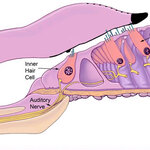Neuroscience

Utah and Texas researchers have learned how quiet sounds are magnified by bundles of tiny, hair-like tubes atop “hair cells” in the ear: when the tubes dance back and forth, they act as “flexoelectric motors” that amplify sound mechanically.
“We are reporting discovery of a new nanoscale motor in the ear,” says Richard Rabbitt, the study’s principal author and a professor and chair of bioengineering at the University of Utah College of Engineering. “The ear has a mechanical amplifier in it that uses electrical power to do mechanical amplification.”
“It’s like a car’s power steering system,”…

When we emerge from a supermarket laden down with bags and faced with a sea of vehicles, how do we remember where we've parked our car and translate the memory into the correct action to get back there? A paper in PLoS Biology identifies the specific parts of the brain responsible for solving this everyday problem, which could have implications for understanding the functional significance of a prominent brain abnormality observed in neuropsychiatric diseases such as schizophrenia.
Different types of memory are formed in different parts of the brain. The repetitive drive to work or to…

New research provides insight into how the brain can execute different actions in response to the same stimulus. The study, published by Cell Press in the April 16 issue of the journal Neuron, suggests that information from single brain cells cannot be interpreted differently within a short time period, a finding that is important for understanding both normal cognition and psychiatric disorders.
Humans exhibit incredible flexibility when it comes to adjusting to the demands of a particular task. For example, when the word "blue" is written in red ink, separate responses to the color or the…

A UQ researcher has revealed a new treatment for a speech disorder that commonly affects those who have suffered a stroke or brain injury.
PhD graduate Dr Rachel Wenke has shown in a recent study that the Lee Silverman Voice Treatment® may be an effective option for dysarthria patients suffering from stroke and traumatic brain injury (TBI).
Dysarthria is a speech disorder which negatively affects a person's ability to communicate as they can be difficult to understand and may sound like they have slurred or unclear speech.
The disorder affects 75% of individuals with…

After about seven months growing in the womb, a human fetus spends most of its time asleep. Its brain cycles back and forth between the frenzied activity of rapid eye movement (REM) sleep and the quiet resting state of non-REM sleep. But whether the brains of younger, immature fetuses cycle with sleep or are simply inactive has remained a mystery - until now.
Mathematician Karin Schwab and a team of neuroscientists at Friedrich Schiller University in Jena, Germany, say they have discovered that very immature sheep fetuses can enter a dreaming sleep-like state weeks before the first rapid eye…

Researchers from the Hotchkiss Brain Institute (HBI) in the Faculty of Medicine at University of Calgary have uncovered the first evidence that neurons talk to ‘glial’ cells in the digestive tract: a discovery that could help find a way to regulate and restore balance in the gut for the one in 10 Canadians suffering from irritable bowel syndrome (IBS) and the more than 200,000 Canadians suffering from inflammatory bowel disease (IBD).
Sometimes referred to as the “second brain”, the enteric nervous system controls function of the digestive tract. Similar to neurons found in the brain,…

According to a new study published by the Mayo Clinic, patients with Parkinson disease (PD) have another problem to deal with. Researchers have found that one in six patients taking therapeutic doses ofcertain prescription drugs for management of PD have developed troubling behavioral symptoms. The most problematic symptoms include compulsive gambling and hypersexuality.
PD is one of the most common degenerative neurological disorders affecting 1.5 million people in the US. PD is characterized by the destruction of neurons responsible for the production of dopamine which allows coordinated…
There isn't a lot that can pull me away from a hockey game.* Such is the power of Wired magazine, and really freaking cool science.
When people see the optical illusion known as "the hollow mask" - a concave face, like the back side of a hollow mask - they see a normal convex face, according to a Wired Science post (see photo below). But the approximately 1 percent of the population with schizophrenia see the concave face.
"Healthy participants perceive a hollow mask as a normal face, presumably due to the strength of constraining top-down influences, while patients with schizophrenia…

Although fractions are thought to be a difficult mathematical concept to learn, the adult brain encodes them automatically without conscious thought, according to new research in the April 8 issue of The Journal of Neuroscience. The study shows that cells in the intraparietal sulcus (IPS) and the prefrontal cortex — brain regions important for processing whole numbers — are tuned to respond to particular fractions. The findings suggest that adults have an intuitive understanding of fractions and may aid in the development of new teaching techniques."Fractions are often considered a major…

Researchers at the University of California, San Diego School of Medicine have compiled the first-ever review of the neurobiology of wisdom – once the sole province of religion and philosophy. The study by Dilip V. Jeste, MD, and Thomas W. Meeks, MD, of UC San Diego's Department of Psychiatry and the Stein Institute for Research on Aging, was published in the Archives of General Psychiatry.
Wisdom has been defined over centuries and civilizations to encompass numerous psychological traits. Components of wisdom are commonly agreed to include such attributes as empathy, compassion or altruism,…